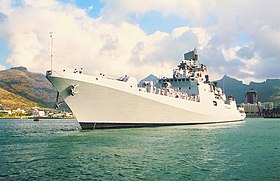Talwar class
| Talwar class | |
|---|---|
 INS tabar (F44) |
|
| Overview | |
| Type | frigate |
| units | 6 in service |
| Shipyard |
Baltic plant , Saint Petersburg |
| Order | 1997 |
| delivery | since 2002 |
| period of service |
since 2003 |
| Technical specifications | |
| displacement |
Standard: 3,780 ts |
| length |
125.3 m |
| width |
15.2 m |
| Draft |
4.9 m |
| crew |
313 (including 40 officers and 13 flight personnel) |
| drive | |
| speed |
32 knots |
| Range |
|
| Armament |
|
| helicopter | |
The Talwar class or Project 1135.6 is a class of frigates in the Indian Navy . The ships are based on the Soviet / Russian Kriwak III class .
The main task of the ships, which have been in service with the Indian Navy since 2003, is anti -submarine defense and the fight against surface ships . The class is named after the Indian saber Talwar .
history
The design of the ships goes back to the 1135.1 ( Krivak III ) project from the early 1980s, which the Severnoje design office modified for Indian conditions. In 1997 the contract to build the first three ships between India and Russia was signed. The ships, which replace the outdated Leander- class ships , were laid down at the Baltic shipyard in Saint Petersburg between March 1999 and May 2000 and launched between May 2000 and May 2001. Two ships entered service with the Indian Navy in June 2003, and the third followed in April 2004.
In the summer of 2006, another construction lot of three ships was ordered, which will be built at the "Jantar" shipyard in Kaliningrad . The first F45 Teg unit was handed over in April 2012 after successful testing and took part in the 823rd Hamburg port birthday right at the start of its long maiden voyage to its future home . In 2012, India was the partner country of the Hanseatic Volksfest. The second unit, F46 Tarkash , was handed over to the Indian Navy in November 2012.
units
| Surname | Shipyard | Launch | Commissioning | status |
|---|---|---|---|---|
| INS Talwar (F40) | Baltic plant | May 12, 2000 | June 18, 2003 | in service |
| INS Trishul (F43) | Baltic plant | November 24, 2000 | June 25, 2003 | in service |
| INS tabar (F44) | Baltic plant | May 26, 2000 | April 19, 2004 | in service |
| INS Teg (F45) | Jantar | November 2009 | April 27, 2012 | in service |
| INS Tarkash (F50) | Jantar | June 2010 | November 9, 2012 | in service |
| INS Trikand (F51) | Jantar | May 2011 | June 29, 2013 | in service |
| Jantar | ordered | |||
| Jantar | ordered | |||
| Goa Shipyard | planned | |||
| Goa Shipyard | planned |
technology
Hull and drive
The basic design of the ships is based on the Soviet / Russian Kriwak III class, which has been improved in terms of the radar cross-section and has stealth properties . The ships are 125.3 meters long, 15.2 meters wide and, with a standard displacement of 3,780 tons, have a draft of 4.9 meters. It is driven by two DS-71 gas turbines , each with an output of 9,000 shp , which each drive a five-bladed propeller. Two Boost-DT-59 gas turbines with 19,500 shp each can be switched on for high-speed travel ( COGAG drive ). The ships have a maximum speed of 32.5 knots . The range is 4,500 nautical miles at 16 knots, 3,900 nautical miles at 20 knots and 900 nautical miles at 30 knots.
Armament and Electronics
There is a UKSK vertical launch system on the forecastle . This consists of eight cells, which can optionally be equipped with eight BrahMos or Klub-N guided weapons.
The anti-aircraft armament of the Talwar class consists of a single launcher for SA-N-12 Grizzly - surface-to-air missiles for medium ranges. The magazine located under the starter holds 24 guided missiles of the type 9M317E or 9M38M. There are also eight shoulder-based short-range surface-to-air missiles of the type 9K310 Igla-1 on board .
For anti-submarine serve 2 533-mm torpedo Two drivers, use up the torpedoes of the type SET 65SE or 53-65KE. In addition, an RBU-6000 12-way depth charge launcher with a total of 48 projectiles is available.
The artillery consists of a 100 mm A-190E gun with a 5P-10E Puma fire control system. The maximum range of the gun is 20 km, the cadence 80 rounds / minute. Depending on the ammunition used, land, sea and air targets can be fought.
For short range defense two serve Kaschtan -CIWS on the hangar roof. In the case of the ships of the second series, these were replaced by two AK-630 M.
For reconnaissance, the frigates have a 3Ts-25E Garpun-B radar and a Fregat M2EM- 3D radar with a detection range of 300 nautical miles. The ships are equipped with a BEL APSOH sonar for underwater location .
Web links
- Full description (Engl.) ( Memento of 8 February 2010 at the Internet Archive )
- Indian Navy website on the Talwar class ( Memento from October 23, 2008 in the Internet Archive )
Individual evidence
- ^ Page of the Indian Navy on the Talwar class ( memento from October 23, 2008 in the Internet Archive ) ( English ).
- ↑ Russia delivers frigate “Tarkash” to India (November 9, 2012). Retrieved November 9, 2012.
- ↑ India signs $ 950 million contract with Russia to buy two stealth frigates, Defense News, October 30, 2018
- ↑ a b c d e Militaryrussia.ru , accessed April 16, 2013 (Russian)
